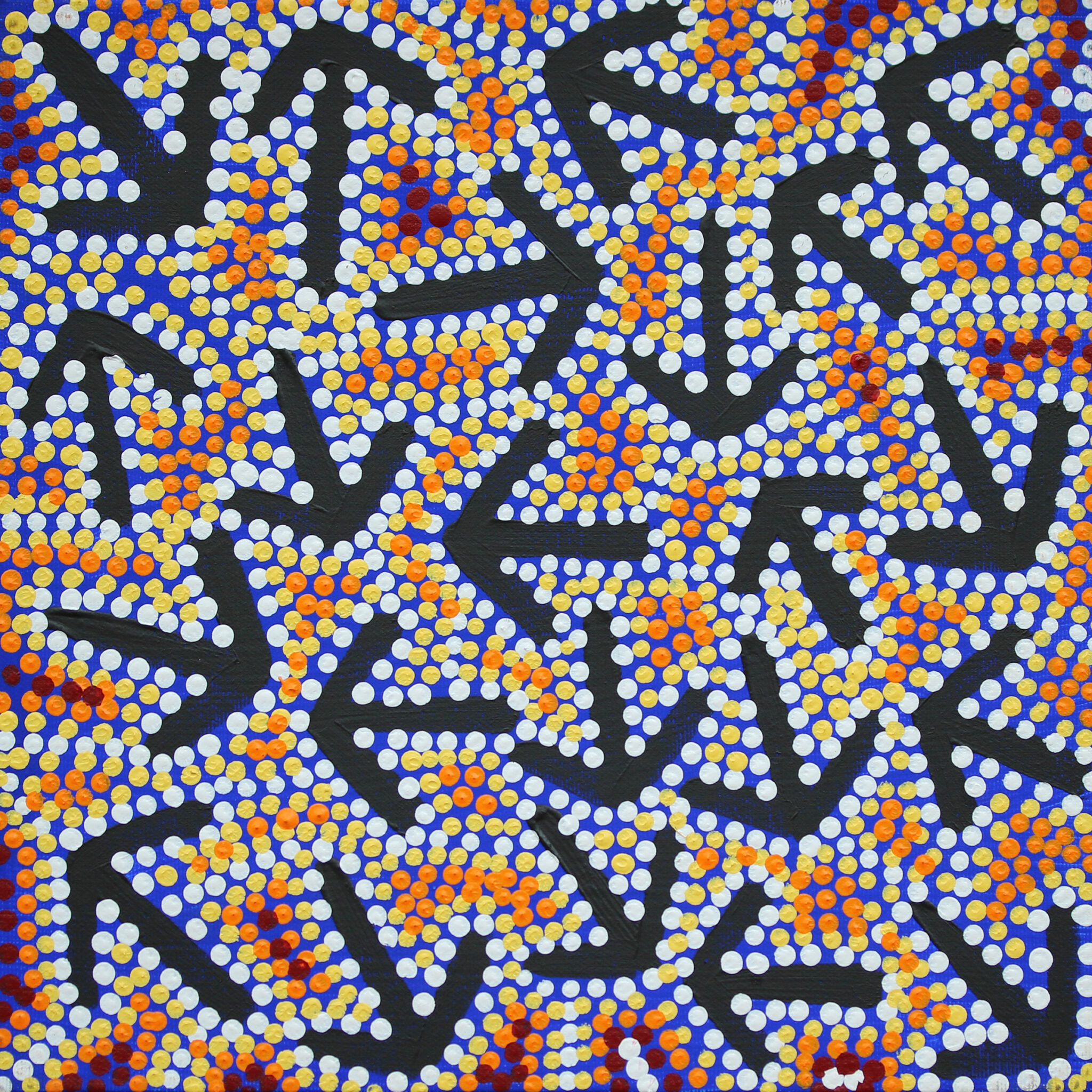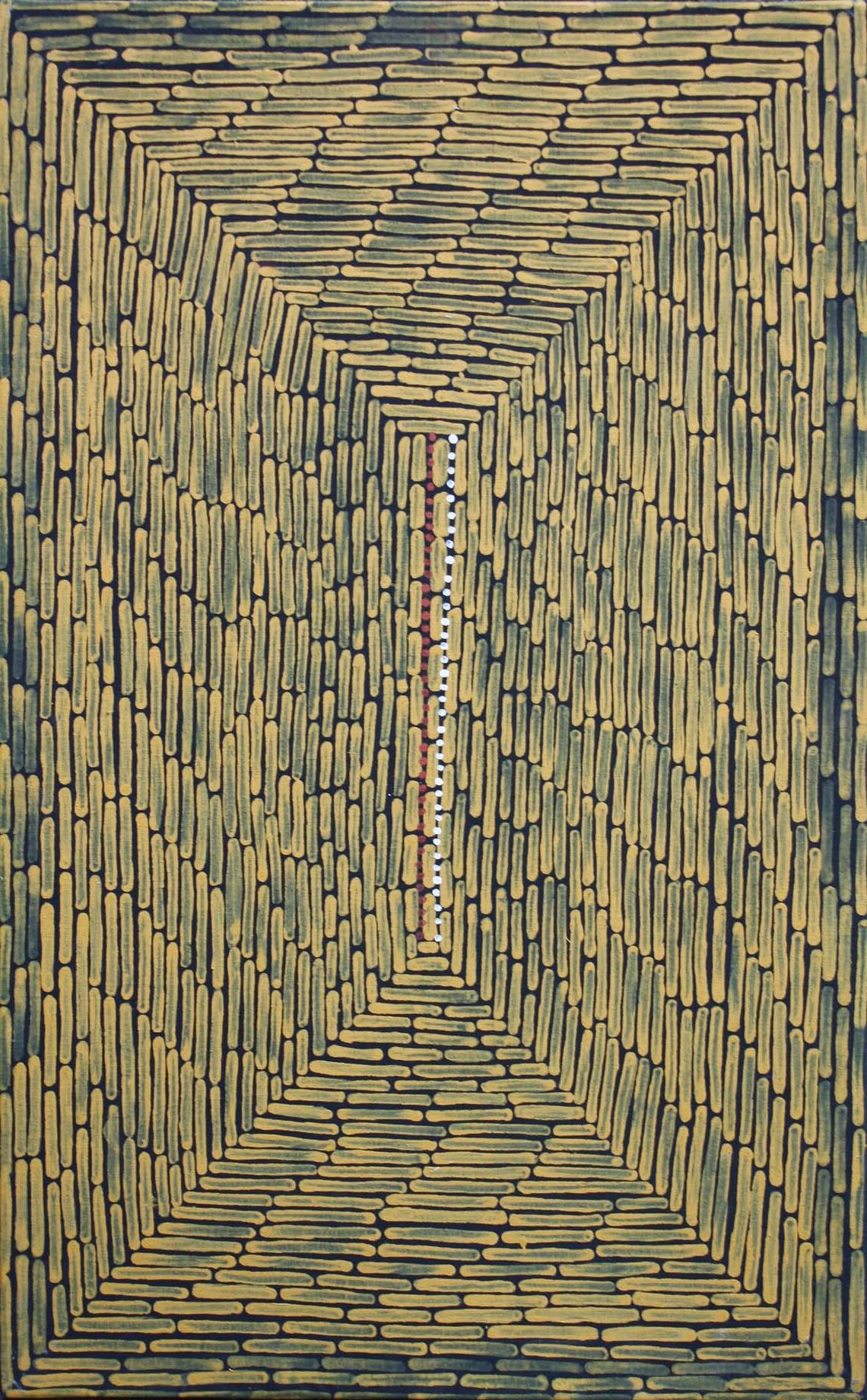Paddy Fordham Wainbarrnga
Details
Biography
Paddy Fordham Wainburranga’s paintings and carved Balangjarngalain spirit figures are without parallel. The loose fluidity of line and form – in two or three dimensions – defies standard conventions. The borders of his paintings on bark and canvas are often crooked, the paint rough and unfinished but an impressive, gestural power dominates each painting. The spirit carvings, unlike the more static mimi figures of the Kurdal, are fluid, waving and suggest movement. Even the artist’s hollow log coffins are marked by potent imagery and spontaneous paint quality.
Paddy Fordham Wainburranga works with a raucous vigour on a plain background, painting vital spirit figures, writhing serpents, circles and dots without concern for symmetry, precision or minute elaboration.
Although Paddy Fordham Wainburranga was taught to paint by his father, his art has branched in another direction and is not confined to the iconography of ritual and mythology. As a result of a lack of ceremonial status, the artist is not entitled to include country-defining symbolism or rarrk used by other Rembarrnga people. Paddy Fordham Wainburranga was displaced from his birth place Bamdibu ( south west of Ramingining ) to Beswick Station, 100 km south east of Katherine.
The Rembarrnga language group from Central Arnhem Land has produced some highly original art practitioners over the years, however, none has matched the thematic inventiveness of Paddy Fordham Wainburranga. As a painter with a philosophical bent of mind, Wainburranga paints Ngalkbun Rembarrnga mythologies but also dedicates himself to recording the history of the region through a remarkable series of works produced since the eighties.
Wainburranga’s personal experiences which shaped his rather eclectic views on life, were similar in many respects to those of other men from his generation. Born in his father’s country at Bandibu, between Malnjangarnak and Bulman, Paddy and his family followed many of the other Rembarrnga to the ration Depot at Maranboy during the wartime. It was later, after limited schooling at the nearby Government settlement Dandangle, that Wainburranga decided to become a stockman, working at various cattle stations from Mataranka to VRD, Killarney and Gorrie Station, then moving to Oenpelli, Goulburn Island and Milingimbi. By 1962 after the introduction of citizenship rights for Aboriginals, he decided to give up being a stockman and went to the recently established settlement of Maningrida to live. Nearly twenty years later he returned to live with his Rembarrnga relations at Beswick. It was here in the early 1980s that Wainburranga began committing his stories to bark.
In 1993 Wainburranga’s painting Eagle Hawk and Crow won the National Aboriginal art award. When asked if he would ever give up painting if he became wealthy he replied:
“No, painting won’t stop. no, I gotta do that. My painting, my Dreamtime, nobody own it for me, nobody can stop this History painting. When I die, young people gotta take it over. That’s why all over the world we meet up, talk together and give history to one another. I give you my painting or you give me your painting. Everything for the children because they going to be taking over.”
Paddy further advanced his painting skills from natural ochre pigment on bark to high quality acrylic paints on linen or canvas. He has been able to maintain his unique style without compromising his traditional iconography.
Paddy’s unique depiction of the Mimi Spirit is the centre piece for most of his paintings. He often paints a dancing Mimi Man, which he says is a good Mimi, he looks over the land as a protector, and only comes out at nights. The Mimi is not visible during the day.
Paddy always includes some small representation of the bush animals that he grew up with, many of these animals are the focal point of significant stories that were passed to him by his father. Animals such as the long and short neck turtles, file snakes, leeches, butterflies, rainbow searpent, (Bolong) and of course the mosquito which is Paddy’s totem and are often seen accompanying the mimi figures which Paddy depicts in his artwork.
Paddy is very loyal to his tradition always encouraging younger people to paint so as to record their history and culture in art for future generations. Paddy can often be heard singing his tribal songs while he is painting. As such he has worked in music, dancing and story – telling as a way of life quite apart from painting and sculpture. He is called on frequently to participate in ceremonies all around the Northern Territory. Paddy is also called upon to take part in events of national importance to Aboriginal people.
In 1988, on the occasion of the Bicentennary of white colonisation of Australia, Paddy took a prominent part in the Aboriginal memorial, completing some 30 of the 200 hollow log coffins made to commemorate Aboriginal deaths since colonisation. He also attended the 5th Pacific Festival of Arts and Culture in Townsville as leader of the Beswick Dancers, and in the same year made a film “Too many Captain Cooks”, to put forward an Aboriginal view of Australian history. Paddy’s work often depicts the spirit figures of his country.
Courtesy of “New Tracks, Old Land”.
Artwork
-
29 Hunter St, Hobart 7000,
Tasmania, Australia - +61 3 6236 9200
- euan@artmob.com.au
Cash – locally only – up to $10,000 only. Layby facilities available. Card details can be advised securely using WhatsApp.
© Art Mob Pty Ltd, Aboriginal Fine Art Dealer, all rights reserved.


